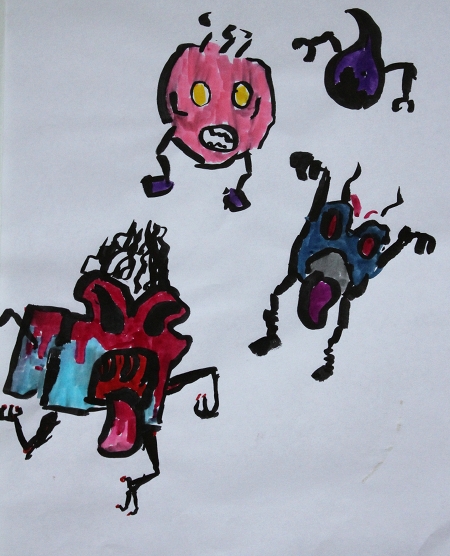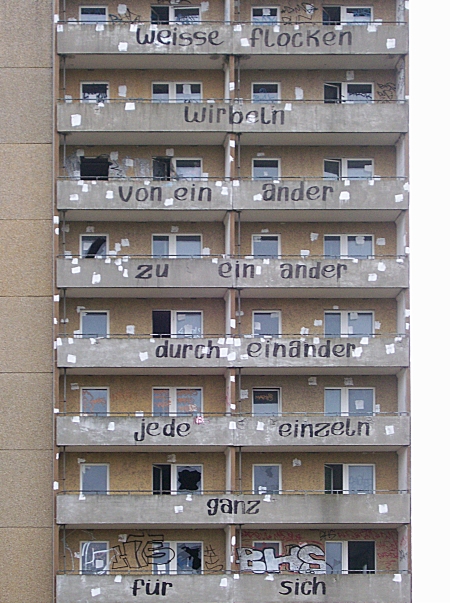mort about education
Tuesday, March 13th, 2012
monsters from a 9 yr. old, more images after the text
randform reader spitzketreiber wrote in a comment to the last blog post:
so you don’t want to mingle your kid with the normal kids in that school, isn’t that elitistic and in contradiction to the egalitarian views you expressed here on this blog?
What do you mean with egalitarian? I think every human has the right for half-way decent living conditions that is in particular everybody should have access to food, housing, education and health care, but thats not egalitarian as in the usual sense.
Moreover I didn’t say that I don’t wan’t to mingle my kid with the “normal” kids.
On the contrary. I do think that it can be good to bring rather different types of kids together. However the size of the classes and the ratio of teachers and or supervisors/social workers to pupils/group members matter a lot if you have different types of pupils/group members. I worked in the early eighties in a preschool where disabled, mentally retarded and “normal” children were brought together in one group. I found it was for all children a win. However for this project the ratio of teacher/supervisor/kid was about one teacher for 1-2 kids and this ratio was definitely necessary.
In general it is important that each kid has something to work on, something were it can grow its abilities. If you have a group of very different kids it is often not so easy to find the right means to realize this.
Like in the case of specific mind tasks you have to keep the intelligent kids busy enough with suited and meaningful tasks so that they don’t start to get too bored. Likewise slower kids need to get a task, which is adapted for them, a task were they feel not swamped and were they have enough freedom to work at their pace. Alpha animals have to be often kept at distance, cultural obstacles have to be resolved, some people need a special amount of physical workout, some people talk a lot, some people are better able to adapt etc. In general one can say the more different a group, the harder it can be to “keep the group together” for a longer time while simultanously get some work done with some portion of efficiency. Moreover with a smaller teacher/kid ratio the evaluation of abilities is more difficult. So it may happen that very different people supplement each other and may easily form a group however in the generic case one can rather observe that often either people sort themselves (“social segregation”) or that they are sorted prior to forming groups and/or that they are “streamlined” via pressure and rules (please see also the comment on the moderation of groups). Thus school classes are e.g. formed by sorting via grades and/or other aspects, like tuition etc. The bigger the classes, the less teachers there are, the more streamlining and sorting may be necessary in order to keep a certain standard. Ever done chemistry experiments with a bunch of over 30 ten year olds in a small room? I did this and I can say it can be challenging.
In a lot of the Berlin gymnasia which are mentioned in the previous blog post there seem, at least by what we have heard, to be less social and cultural differences than in that gymnasium in Marzahn-Hellersdorf at which our kids are currently. In that sense it seems the social and cultural components of difference may be lower in these schools then in this school in Marzahn-Hellersdorf and thus if you have the same amount of too many pupils this may be a learning advantage.
In the case of our son we thus have – apart from the Berlin-Bavarian problem with spanish as a second language (which wouldn’t be resolved by sending him into a “normal” class at this school and I am still quite angry that they didn’t tell us when we applied for that school that french is going to be eliminated) – to figure out wether it is better for our son to stay in his “presorted” class with a higher teacher ratio per kid, however with a higher teaching speed (“fastgoerclass”) or to change to a rather crowded class with probably more tensions due to more and more different pupils. I should also say that depite the fact that his class was already more “sorted” than a “normal” class (kids in these kind of classes have often parents which have a high interest in good education) there were already big overall tensions (especially among the boys) and that the math teacher spend his free time to speak with the boys and to establish a kind of anti-bullying system. One should also mention that the school had to undergo a major restructuring and that there is a rather high fluctuation of teachers, because of e.g. changing pupil numbers, the restructuring and school reforms. So for example my daughters class has now the fifth math teacher (temporary staff not included) in four years. Moreover an overall higher teaching speed (as said the gymnasia in Germany were roughly shortened by a year in recent times) together with higher challenges of a technological society put additional pressure on schools and kids. This school in Marzahn-Hellersdorf has some excellent teachers and it is frustrating to see how they are struggling. There was recently also a study, which displayed that the current german school system produces a lot of “loosers”, from the article Deutschland, Land der Schulabsteiger
“Selbst in Sachsen, dem informellen Sieger der neuen Studie, kommen auf einen Schulaufsteiger elf Schüler, die aus dem Gymnasium in eine niedrigere Schulform herabgestuft werden. In Niedersachsen sind es 12, in Berlin gar 14.”
translation without guarantee:
Even in Saxonia, the informal winner in the study, it was that for one fast climber there are eleven pupils which are decending from Gymnasium into a lower school form. In Lower Saxonia there are 12 and in Berlin even 14.
Big classes are of course motivated by economic considerations and similar dynamics with high teach speed and bigger “classes” take place in higher education. For example a year and a half ago Tim had to give lectures in front of about 1000 ! students – he had already to think about wether it may be necessary to split his lecture via a video screen into two lecture halls. I call this an academic Musikantenstadl.
The New York times had recently an article which conscisely summarized two major components of these dynamics. One effect is the socalled “Baumol’s disease”:
Some of that growth has resulted from a phenomenon called Baumol’s disease, after the economist William J. Baumol, who described it in a 1965 article he wrote with William G. Bowen. The basic idea is that while productivity gains have made it possible to assemble cars with only a tiny fraction of the labor that was once required, it still takes four musicians nine minutes to perform Beethoven’s String Quartet No. 4 in C minor, just as it did in the 19th century.
College instruction more closely resembles a musical performance than an auto assembly line. Although information technologies have yielded some productivity growth in academia, instruction still takes place largely as it always has.
In some sense one can see this dynamics as a indication that humans (the training of, the maintanance of etc.) are loosing against the market competivity of machines and this is not only the case for the industry sector but increasingly also the case for the socalled knowledge economy. Note in particular that teaching becomes especially part of the monetarily sucessful section of knowledge economy if it is not mainly concerned with teaching “mentally weak” humans (or whoever appear as such) but humans which are able to construct, run and maintain high tech, i.e. “machines.”
This becomes also apparent in the second phenomenom which lies according to the New York times in “prestige hunting” (and the corresponding tuition costs):
“After adjusting for inflation, starting salaries for most graduates have remained essentially stagnant for several decades, while those at the bottom of the group have actually declined. Only the highest-paid graduates have enjoyed significant salary growth, and among those a very thin slice at the top has seen truly spectacular increases.
Because of the bitter competition for those premium salaries, elite educational credentials are often a precondition for even landing a job interview. With so many applications for every vacancy, many consulting firms and investment banks, For example, now consider only candidates from a short list of top-ranked schools.”
That is consulting firms and investment banks are of course to a great extend part of what can be seen as “knowledge economy”, in particular sophisticated financial instruments make extensive use of computers, i.e. “machines” and the humans, which are assumed to be able to create e.g. the best computer programs and financial models are thus more sought after.
More components like growing social inequalities and declining ressources play of course also a role.

car and gadget design from a 10 yr. old









